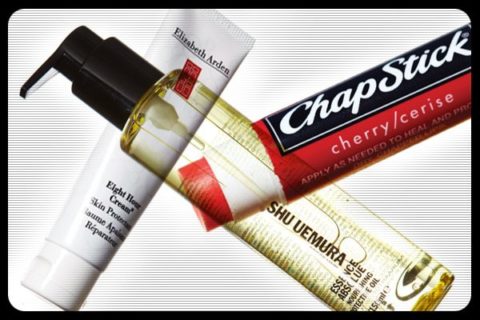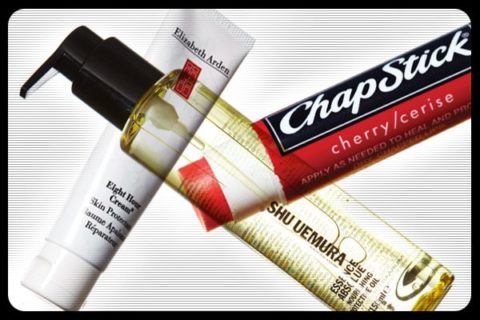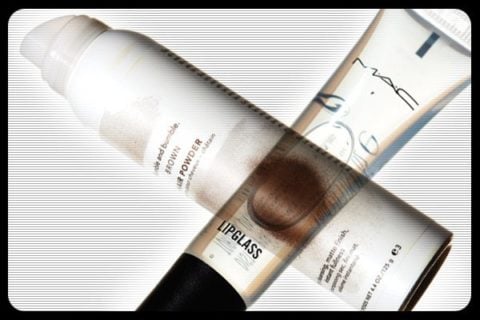Hollywood beauty: Meet the hair and makeup artists behind film and TV’s influential looks


Featured from left to right: Elizabeth Arden Eight Hour Cream skin protectant ($25, at Shoppers Drug Mart) was used to give skin a sheen in A Single Man. Shu Uemura Essence Absolue nourishing protective oil ($68, shuuemura.com) makes damaged strands “shine like baby hair,” says Cornell. Chapstick ($3, at Shoppers Drug Mart) in “Cherry” is offers’ go-to lip tint.
Almost every season, Hollywood has a way of asserting its influence on the runways, with leading ladies from contemporary and iconic films inspiring makeup and hair at several shows. For Fall 2011 alone, makeup artist Val Garland painted a smoky eye at Sophie Theallet to evoke a modern-day Faye Dunaway in Bonnie and Clyde, while at Dsquared, she channelled Nicole Kidman in Cold Mountain. And Garland wasn’t the only one mining imdb for muses. Hairstylist Eugene Souleiman had Hailee Steinfeld in mind while he weaved what he refers to as “Amish/True Grit braids” at Kenzo.
Behind these big-screen nods are the people who created the looks in the first place—the makeup artists and hairstylists who work in film and television. Their artistic achievements often become pop-culture moments, referenced for years by everyone from photographers to fashion designers. And yet, unlike the beloved onscreen characters they help conceive, they’re not known outside of their industry. Their “celebrity” counterparts, however, are almost as famous as the clientele they primp for awards show season, getting name-checked in every magazine from Us Weekly to In Style. But their worlds, and their work, couldn’t be more different.
“What they do is an art unto themselves,” explains Sue Cabral-Ebert, president of the Make-Up Artists and Hair Stylists Guild in Los Angeles. “But what we do is just as great, and because it takes place over a longer period of time, it’s harder.” Makeup and hair have the power to communicate many things about characters onscreen, from their lifestyle and socio-economic status to where they grew up, says Cabral-Ebert. “We don’t just make the actor look pretty, we develop an entire character. Because it’s an organic process, you have to know what’s in your script, what the history of this character is and where the character is going.”
Film makeup and hair artists begin their process in the same way as an actor: by poring over a script. If it’s a period piece, artists do extensive research and gather photographs, often sourced from unofficial industry bibles such as Richard Corson’s Fashions in Hair and Fashions in Makeup, which go as far back as ancient Egypt. But with contemporary films, the process is much more collaborative, involving meetings with actors and costume designers to delve into the character: Where would they shop? Which brands would they choose? Would they get their hair professionally highlighted? “It’s an ensemble thing between the actor, the director, the costume designer and yourself,” explains hairstylist Jerry DeCarlo, who’s busy crafting some of the Prohibition-era looks for HBO’s Boardwalk Empire.

Featured from left to right: L’Oréal Paris Elnett Satin HairSpray for colour-treated hair ($15, at drugstores) is a favourite, says DeCarlo. For lip colour that withstands onscreen kisses, Offers uses Benefit benetint rose-tinted lip & cheek stain ($36, at Shoppers Drug Mart).
On set in Baltimore, makeup artist Elaine Offers is using all of her makeup-artistry might to transform Julianne Moore into Sarah Palin for Game Change, an HBO flick out later this year. When the pair worked together on The Kids Are All Right, in which Moore portrayed one half of a gay couple, “Julianne knew exactly who she wanted to be. She has friends who are lesbians, and they are working mothers who don’t have a lot of time. They looked like they took good care of their skin, and they were just simpler ladies,” says Offers. To convey that low-maintenance approach to beauty, Offers skipped mascara and dyed Moore’s eyelashes and eyebrows a soft auburn. And since they agreed that the character would never have worn lipstick, she enlisted her humble makeup bag staple: cherry ChapStick. “I use it constantly because it’s not too shiny on camera and it does give a tiny bit of a pink tint.”
Offers was also behind Cate Blanchett’s lit-from-within skin in The Curious Case of Benjamin Button. Director David Fincher gave her total autonomy, a creative coup the artist says happens about 75 per cent of the time. Once Blanchett’s character, Daisy, turned 40, Greg Cannom—who won an Oscar for his age-enhancing work on the film—started to create wrinkles, crow’s feet and a little bit of crepiness around Blanchett’s jawline and neck. Then Offers applied the era-appropriate makeup over top. “That’s the way we worked up until [Cate’s character] was very old, and then it was Greg and his team that were doing all of the prosthetics and airbrushing and the other brilliant stuff they do.”
Unlike Fincher, Tom Ford had a strong vision for the hair and makeup in his directorial debut, A Single Man, which also stars Moore. “We both wanted her to be fabulous looking,” says Offers, “and that meant great eyes with a lot of black eyeliner, false lashes and pale lips.” Nails are also part of a makeup artist’s duty when working on a film. “We decided that tips and acrylic were needed to complete Moore’s look, along with a pale, creamy coral polish.”
Makeup artist Kate Biscoe, who is currently working on Steven Soderbergh’s Contagion, also worked on A Single Man and can attest to Ford’s passion for creating the characters’ looks, not to mention his vast beauty lexicon, which outshone other directors she had worked with. “He wasn’t the kind of guy who was like, ‘I think she needs some more rouge.’ He would be like, ‘Can you put a little bit of [Elizabeth Arden] Eight Hour Cream on the high points?’”

Featured from left to right: Cornell goes through “cans and cans” of Bumble and Bumble hair powder ($50, bumbleandbumble.com) in “Brown” to fill in thinning hair. M.A.C LipGlass ($18, maccosmetics.com) in “clear” doubles as tear drops, says Biscoe.
After collaborating with Ford, Biscoe had another enviable task: spray-tanning Robert Pattinson’s pale skin to reflect his character’s lifestyle change in Water for Elephants. “After he joins the circus, he’s out pitching tents and hauling stuff around,” she explains. “He’s a working man, and he’s dirty and grimy, and the sun’s been beating down on him.” She also oversaw the circus performers and extras, paying careful attention to correct contemporary brow shapes and tattoo ink— “They only had certain inks in 1933”—two things that can be glaring mistakes in a period piece.
As challenging as it is to nail down the makeup from a particular era, the craft involved in styling hair for period work is “more exacting than makeup,” says Cabral-Ebert. “The hair frames the [decade] and tells exactly what the time period is—immediately.” Considered a go-to guy for retro hair looks, DeCarlo rhymes off his encyclopedic knowledge like Rain Man. “Hair changes for a reason. It morphs from one decade to another because of political or financial [events] like the stock market crash—hair got longer because women could no longer afford to get it cut, and it continued to get longer into the ’40s, and then women’s hair was pulled away with combs, and it was all mainly to keep it away from the factory machines.”
One of DeCarlo’s recent projects, the HBO miniseries Mildred Pierce, spanned more than one decade, something he had to take into consideration. “Everybody thinks that fashion changes on the decade, but it doesn’t conform that way,” he says. “The hair starts to change by the late ’30s and starts to look more like the ’40s. We tried to show that transition.”
Whether replicating the look of a historical figure like Pierce or creating a new character, continuity always presents a challenge for hairstylists and makeup artists because a film’s scenes are rarely shot in the order in which they are shown. “In one day’s work, you can have several hair changes on an actor,” explains hairstylist Cydney Cornell, who cites Canadian Paul LeBlanc (the man behind famous onscreen lids like Javier Bardem’s creepy mop in No Country for Old Men) as an inspiration. In Natural Born Killers, as Juliette Lewis spins between states like a psychopathic twister, she has a different hairstyle in almost every sequence, with no explanation. “Oliver [Stone, the director] told me not to worry about continuity. He used this concept to help him tell the story about the craziness of the lives of the characters and their world,” she says.
Seventeen years later, Lewis’s onscreen persona inspired makeup artist Lucia Pieroni, who referenced the cult classic at Missoni, smudging black liner around the eyes and giving lips a burgundy stain. Though models were playing the part of “kick-ass cool girls with a masculine edge,” explains Pieroni, these roles have a shorter lifespan than the characters that evolve over lengthy shooting schedules. “The runway or red carpet stuff, that’s a one-time thing that emphasizes [a designer’s collection] or someone’s personality. What we do is character development,” says Cabral-Ebert, before she shares a story emphasizing the contrast between the two worlds. “There was one celebrity stylist who was requested [by his client] on a film, and he was bored to tears—he never wanted to do a film again. The ‘hurry up and wait,’ the long hours over a long period of time—it just wasn’t what he did.”







